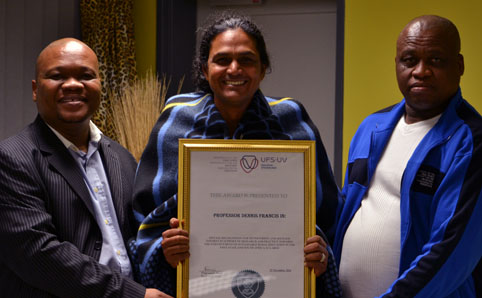 |
|
MEC Mr Tate Makgoe (left) with Faculty of Education’s Prof. Dennis Francis, holding the inaugural SURLEC Award. With them is Dr Dipane Hlalele.
Photo: Thabo Kessah
|
Universities have the responsibility to respond to the challenges that the South African education system is faced with.
This is the view of the Free State MEC for Education, Mr Tate Makgoe, during his address at the three-day First Sustainable Rural Learning Ecologies (SURLEC) Colloquium, which was recently held at the Qwaqwa Campus of the University of the Free State (UFS).
“Our universities must not only research the failures of our system. They must also come up with solutions.
“One of the questions that demand answers in our country is whether we produce quality teachers at our universities, considering our learners’ performance internationally. Our children lack the basics like grammar and yet we are 17 years into democracy. Why is their performance so poor in comparison to children in poorer countries?” asked Mr Makgoe.
“We must work together as a Government and universities to change this. Universities must be anchors of democracy and freedom, which is meaningless if our children cannot read and write. We must also focus on Mathematics and Natural Sciences, not forgetting to value our indigenous knowledge and games to enhance learning, especially in Mathematics,” he said.
According to Dr Dipane Hlalele, Head of the Faculty of Education at the UFS Qwaqwa Campus, the colloquium was held to search for best practices and success stories relating to the theme, Creating sustainable rural learning ecologies in the 21st century.
“Our objective was to tap into experiences and wisdom of policy makers, researchers, scholars, teachers and students in order to map a new direction in research as well as to make an indelible mark on the revitalisation of this campus,” concluded Dr Hlalele.
The UFS Dean of Education, Prof. Dennis Francis’ efforts to improve rural education were honoured with the first ever SURLEC Award.
Over 70 research papers from the universities of the Free State, South Africa, Venda, KwaZulu-Natal, Limpopo and the Cape Peninsula University of Technology were delivered and learners from the local schools like The Beacon, Mafube, Qwaqwa and Clubview presented their winning projects at the Science Expo.